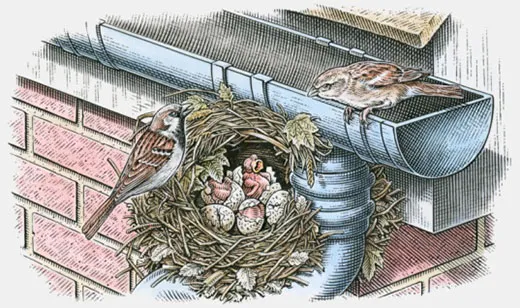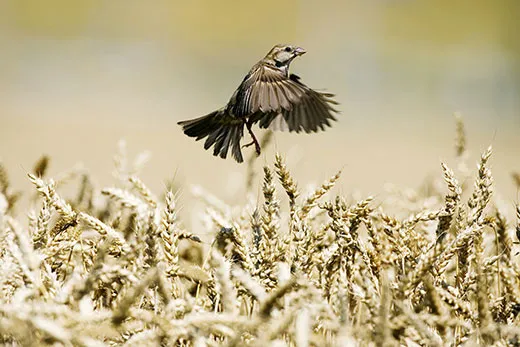The Story of the Most Common Bird in the World
Why do we love what is rare and despise what is all around us?
/https://tf-cmsv2-smithsonianmag-media.s3.amazonaws.com/filer/house-sparrow-flying-above-wheat-field-631.jpg)
Even if you don’t know it, you have probably been surrounded by house sparrows your entire life. Passer domesticus is one of the most common animals in the world. It is found throughout Northern Africa, Europe, the Americas and much of Asia and is almost certainly more abundant than humans. The birds follow us wherever we go. House sparrows have been seen feeding on the 80th floor of the Empire State Building. They have been spotted breeding nearly 2,000 feet underground in a mine in Yorkshire, England. If asked to describe a house sparrow, many bird biologists would describe it as a small, ubiquitous brown bird, originally native to Europe and then introduced to the Americas and elsewhere around the world, where it became a pest of humans, a kind of brown-winged rat. None of this is precisely wrong, but none of it is precisely right, either.
Part of the difficulty of telling the story of house sparrows is their commonness. We tend to regard common species poorly, if at all. Gold is precious, fool’s gold a curse. Being common is, if not quite a sin, a kind of vulgarity from which we would rather look away. Common species are, almost by definition, a bother, damaging and in their sheer numbers, ugly. Even scientists tend to ignore common species, choosing instead to study the far away and rare. More biologists study the species of the remote Galapagos Islands than the common species of, say, Manhattan. The other problem with sparrows is that the story of their marriage with humanity is ancient and so, like our own story, only partially known.
Many field guides call the house sparrow the European house sparrow or the English sparrow and describe it as being native to Europe, but it is not native to Europe, not really. For one thing, the house sparrow depends on humans to such an extent it might be more reasonable to say it is native to humanity rather than to some particular region. Our geography defines its fate more than any specific requirements of climate or habitat. For another, the first evidence of the house sparrow does not come from Europe.
The clan of the house sparrow, Passer, appears to have arisen in Africa. The first hint of the house sparrow itself is based on two jawbones found in a layer of sediment more than 100,000 years old in a cave in Israel. The bird to which the bones belonged was Passer predomesticus, or the predomestic sparrow, although it has been speculated that even this bird might have associated with early humans, whose remains have been found in the same cave. The fossil record is then quiet until 10,000 or 20,000 years ago, when birds very similar to the modern house sparrow begin to appear in the fossil record in Israel. These sparrows differed from the predomestic sparrow in subtle features of their mandible, having a crest of bone where there was just a groove before.
Once house sparrows began to live among humans, they spread to Europe with the spread of agriculture and, as they did, evolved differences in size, shape, color and behavior in different regions. As a result, all of the house sparrows around the world appear to have descended from a single, human-dependent lineage, one story that began thousands of years ago. From that single lineage, house sparrows have evolved as we have taken them to new, colder, hotter and otherwise challenging environments, so much so that scientists have begun to consider these birds different subspecies and, in one case, species. In parts of Italy, as house sparrows spread, they met the Spanish sparrow (P. hispaniolensis). They hybridized, resulting in a new species called the Italian sparrow (P. italiiae).
As for how the relationship between house sparrows and humans began, one can imagine many first meetings, many first moments of temptation to which some sparrows gave in. Perhaps the small sparrows ran—though “sparrowed” should be the verb for their delicate prance—quickly into our early dwellings to steal untended food. Perhaps they flew, like sea gulls, after children with baskets of grain. What is clear is that eventually sparrows became associated with human settlements and agriculture. Eventually, the house sparrow began to depend on our gardened food so much so that it no longer needed to migrate. The house sparrow, like humans, settled. They began to nest in our habitat, in buildings we built, and to eat what we produce (whether our food or our pests).
Meanwhile, although I said all house sparrows come from one human-loving lineage, there is one exception. A new study from the University of Oslo has revealed a lineage of house sparrows that is different than all the others. These birds migrate. They live in the wildest remaining grasslands of the Middle East, and do not depend on humans. They are genetically distinct from all the other house sparrows that do depend on humans. These are wild ones, hunter-gatherers that find everything they need in natural places. But theirs has proven to be a far less successful lifestyle than settling down.
Maybe we would be better without the sparrow, an animal that thrives by robbing from our antlike industriousness. If that is what you are feeling, you are not the first. In Europe, in the 1700s, local governments called for the extermination of house sparrows and other animals associated with agriculture, including, of all things, hamsters. In parts of Russia, your taxes would be lowered in proportion to the number of sparrow heads you turned in. Two hundred years later came Chairman Mao Zedong.
Mao was a man in control of his world, but not, at least in the beginning, of the sparrows. He viewed sparrows as one of the four “great” pests of his regime (along with rats, mosquitoes and flies). The sparrows in China are tree sparrows, which, like house sparrows, began to associate with humans around the time that agriculture was invented. Although they are descendants of distinct lineages of sparrows, tree sparrows and house sparrows share a common story. At the moment at which Mao decided to kill the sparrows, there were hundreds of millions of them in China (some estimates run as high as several billion), but there were also hundreds of millions of people. Mao commanded people all over the country to come out of their houses to bang pots and make the sparrows fly, which, in March of 1958, they did. The sparrows flew until exhausted, then they died, mid-air, and fell to the ground, their bodies still warm with exertion. Sparrows were also caught in nets, poisoned and killed, adults and eggs alike, anyway they could be. By some estimates, a billion birds were killed. These were the dead birds of the great leap forward, the dead birds out of which prosperity would rise.
Of course moral stories are complex, and ecological stories are too. When the sparrows were killed, crop production increased, at least according to some reports, at least initially. But with time, something else happened. Pests of rice and other staple foods erupted in densities never seen before. The crops were mowed down and, partly as a consequence of starvation due to crop failure, 35 million Chinese people died. The great leap forward leapt backward, which is when a few scientists in China began to notice a paper published by a Chinese ornithologist before the sparrows were killed. The ornithologist had found that while adult tree sparrows mostly eat grains, their babies, like those of house sparrows, tend to be fed insects. In killing the sparrows, Mao and the Chinese had saved the crops from the sparrows, but appear to have left them to the insects. And so Mao, in 1960, ordered sparrows to be conserved (replacing them on the list of four pests with bedbugs). It is sometimes only when a species is removed that we see clearly its value. When sparrows are rare, we often see their benefits; when they are common, we see their curse.
When Europeans first arrived in the Americas, there were Native American cities, but none of the species Europeans had come to expect in cities: no pigeons, no sparrows, not even any Norway rats. Even once European-style cities began to emerge, they seemed empty of birds and other large animals. In the late 1800s, a variety of young visionaries, chief among them Nicholas Pike, imagined that what was missing were the birds that live with humans and, he thought, eat our pests. Pike, about whom little is known, introduced about 16 birds into Brooklyn. They rose from his hands and took off and prospered. Every single house sparrow in North America may be descended from those birds. The house sparrows were looked upon favorably for a while until they became abundant and began to spread from California to the New York Islands, or vice versa anyway. In 1889, just 49 years after the introduction of the birds, a survey was sent to roughly 5,000 Americans to ask them what they thought of the house sparrows. Three thousand people responded and the sentiment was nearly universal: The birds were pests. This land became their land too, and that is when we began to hate them.
Because they are an introduced species, now regarded as invasive pests, house sparrows are among the few bird species in the United States that can be killed essentially anywhere, any time, for any reason. House sparrows are often blamed for declines in the abundance of native birds, such as bluebirds, though the data linking sparrow abundance to bluebird decline are sparse. The bigger issue is that we have replaced bluebird habitats with the urban habitats house sparrows favor. So go ahead and bang your pots, but remember, you were the one who, in building your house, constructed a house sparrow habitat, as we have been doing for tens of thousands of years.
As for what might happen if house sparrows became more rare, one scenario has emerged in Europe. House sparrows have become more rare there for the first time in thousands of years. In the United Kingdom, for example, numbers of house sparrows have declined by 60 percent in cities. As the birds became rare, people began to miss them again. In some countries the house sparrow is now considered a species of conservation concern. Newspapers ran series on the birds’ benefits. One newspaper offered a reward for anyone who could find out “what was killing our sparrows.” Was it pesticides, some asked? Global warming? Cellphones? Then just this year a plausible (though probably incomplete) answer seems to have emerged. The Eurasian sparrowhawk (Accipiter nisus), a hawk that feeds almost exclusively on sparrows, has become common in cities across Europe and is eating the sparrows. Some people have begun to hate the hawk.
In the end, I can’t tell you whether sparrows are good or bad. I can tell you that when sparrows are rare, we tend to like them, and when they are common, we tend to hate them. Our fondness is fickle and predictable and says far more about us than them. They are just sparrows. They are neither lovely nor terrible, but instead just birds searching for sustenance and finding it again and again where we live. Now, as I watch a sparrow at the feeder behind my own house, I try to forget for a moment whether I am supposed to like it or not. I just watch as it grabs onto a plastic perch with its thin feet. It hangs there and flutters a little to keep its balance as the feeder spins. Once full, it fumbles for a second and then flaps its small wings and flies. It could go anywhere from here, or at least anywhere it finds what it needs, which appears to be us.
Rob Dunn is a biologist at North Carolina State University and the author of The Wild Life of Our Bodies. He has written for Smithsonian about our ancestors’ predators, singing mice and the discovery of the hamster.


